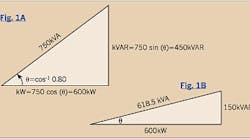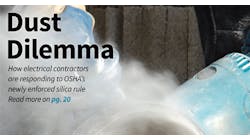You don't always get what you pay for
Electricity is always used to facilitate a function, whether it's running a fan, illuminating a room, or heating a tank of water. However, it's the work done by the appliance — in these cases an induction motor, fluorescent lamp, and water heater, respectively — that is of interest.
Appliances are energy conversion devices. As dictated by the rules of power factor and efficiency, the energy consumed by an appliance is always greater than the energy provided by it.
Power factor. When voltage and current are out-of-phase, the cosine of the angular displacement is called the power factor (PF), or more specifically, the displacement power factor (DpPF). Displacing the current waveform from the voltage waveform reduces the electricity's effectiveness in doing work.As the number of electronic appliances in use increases, so does the presence of harmonic currents, which are integer multiples of the fundamental power system frequency of 60 Hz, such as 120 Hz, 180 Hz, and so on. These harmonic currents distort the shape of the current waveform. Instead of a pure sine wave, current waveforms rich in harmonics tend to be flattened or peaked. This distortion leads to distortion power factor (DtPF), or the ratio of the fundamental frequency current magnitude to the effective current magnitude. The effective current is an equivalent sinusoidal current that produces the same heating effects as the total non-sinusoidal current.
DpPF is often incorrectly referred to as PF. As power quality plays more of a role in power engineering, total power factor (PF=DpPF×DtPF) will become more common.
Power factor correction. Consider a 750kVA load operating at 80% lagging PF. Construct a power triangle to help determine the kW and kVAR components of the power ( Fig. 1A above).Solving for the real and reactive power values yields 600kW and 450kVAR, respectively. So of the 750kVA drawn from the source, only 600kW, or 80% of it, can do useful work. The reactive power, necessary to establish electromagnetic fields, adds a considerable burden to the source.
Last month's column showed that capacitors connected from line-to-neutral can furnish reactive power. With a 300kVAR shunt capacitor, the source has to provide only 150kVAR (450-300=150). Fig. 1B shows the resulting power triangle.
The kVA supplied by the source decreases to
and the PF angle θ decreases to
yielding a new power factor of cos 14°, or 97% lagging. This process of installing shunt capacitors to supply reactive power is called power factor correction.
Depending on the type of appliance, energy can “escape” in a number of places. Electrical losses (I2R) usually account for a significant portion of the total losses, producing heat in the appliance. Iron-core devices exhibit hysteresis losses, which are magnetic losses in the iron, and eddy current losses, which are electrical losses in the iron core. Induction motors and transformers display a significant leakage reactance, which are the losses due to inductance. As the harmonic content of the current increases, skin effect losses increase greatly in the conductors. Rotating machines have rotational losses due to bearing friction and rotor windage.
Although many appliances are designed for maximum efficiency, losses will never be eliminated.



